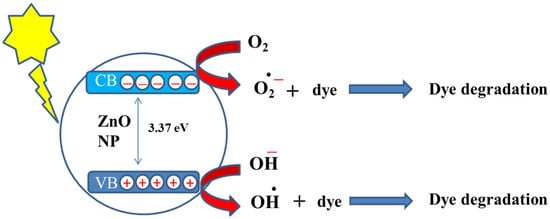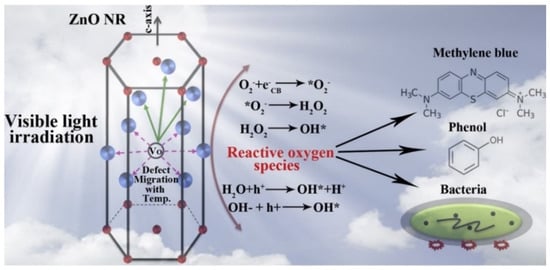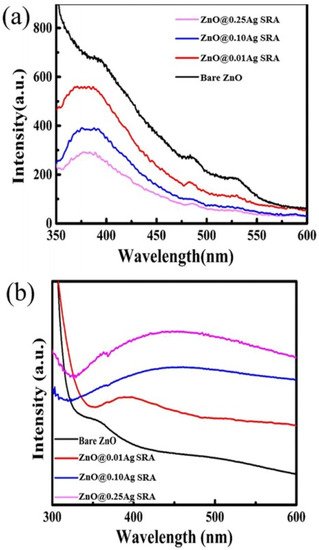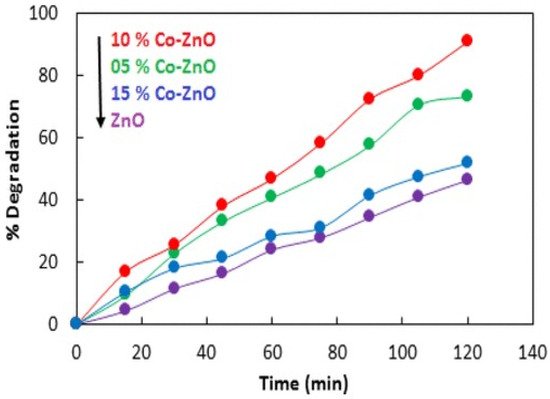2. Use of ZnO for the Breakdown of Dyes
Zinc oxide is extensively used for the breakdown of potentially harmful water pollutants. The majority of commonly used water treatment methods such as chemical treatment, adsorption, and membrane filtration are useful, but inadequate for complete removal of pollutants from wastewater [
39]. Additionally, these approaches produce by-products such as sludge as solid waste and toxic gases that need further treatment. Therefore, for effective water clean-up, visible light active zinc-oxide-based photocatalysis is receiving special attention. Photocatalysis uses photoexcited charge carriers for the breakdown of organic contaminants. The photoactivity of ZnO is utilized for destroying such water toxins [
40].
Shinde et al. [
41] investigated two methods of dye degradation. In one method, the transport of electron into CB of photocatalyst occurs by photon having energy equal to or greater than the band gap of nanoparticles. The excited electrons result in the formation of holes in valence band. The generated electrons and holes leads to free radical formation [
42]. The oxidation of pigments is triggered by the holes present in the valence band.
The second method involves dye sensitization, where dye on the water surface absorbs visible radiation. The absorbed photon excites electrons of dye molecules from HOMO to LUMO. The electron present in LUMO shifts to the conduction band of ZnO. On reaction with O2, this electron yields O2−, which causes the breakdown of pollutants present in water. The schematics of both methods can be seen in Figure 5.
Figure 5. Schematics of the photoexcitation of the dye followed by its photocatalytic degradation under solar irradiation.
T. Bora et al. [
43] reported the potential antibacterial activity of ZnO nanorods and their photocatalytic activity towards the breakdown of methylene blue and phenol (
Figure 6). The rate constant for photocatalytic breakdown of methylene blue dye and phenol was found to be 0.032 and 0.094 min
−1, respectively, at 250 °C. Similarly, ZnO doped with Ag degrades organic dyes by the prevention of hole and electron recombination, which enhances the photocatalytic activity, as expected [
44]. The degradation efficiency of ZnO doped with silver was found to be 99.64% against rhodamine B.
Figure 6. Mechanism of antibacterial and photocatalytic activity of ZnO nanorods. Adapted with permission from [
43]. Copyright 2017, Elsevier.
Kumar et al. [
45] also discovered that the photocatalytic activity of ZnO is increased on doping with Ag. Nanoparticles of Ag-ZnO developed with 0.02, 0.04, and 0.06 percent of Ag showed 3.03 eV, 3.01 eV, and 2.96 eV band gaps, respectively. As discussed earlier, doping lowers the energy required to shift an electron from valence band to conduction band [
46]. William et al. [
47] used Ag-doped ZnO thin film for the degradation of methylene blue. The results of their experiments revealed that silver-doped ZnO degrades dye more effectively (45.1%) than a pure ZnO (2.7%) film under irradiation of VL. In the same area of study, Sabry et al. [
48] carried out some modification in Ag-doped ZnO nanostructure by introducing stearic acid for the breakdown of methylene blue and achieved 93% breakdown efficiency after 80 min exposure to visible light. Liu et al. [
49] also used doped Ag-ZnO and found it to be effective for the degradation of Congo Red.
Figure 7 presents the optical properties of doped ZnO by photoluminescence and UV/Vis absorption spectroscopy. Using the W Xe lamp, Congo Red, Methyl Orange, and Methylene Blue were photocatalytically broken down. A 0.25 M Ag-doped ZnO showed maximum photocatalytic activity of 91.9% in 120 min under a solar light simulator.
Figure 7. (
a) Room temperature PL spectra of samples synthesized by electrolytes containing different concentrations of Ag
+. (
b) UV/Vis absorption spectra of bare ZnO and Ag-ZnO submicrometer rods. Adapted with permission from [
49]. Copyright 2019, ACS.
Saffari et al. [
50] prepared pure ZnO and P-containing ZnO for Rhodamine B degradation. Using a halogen lamp, visible light in the wavelength range of 375–1000 nm was employed. A lowering in the electrons and holes recombination rate in the sample containing 1.8% of phosphorus resulted in complete breakdown of RhB dye in 180 min. Kuriakose et al. [
51] applied Cu-doped ZnO for the degradation of methyl orange and methylene blue dyes. Furthermore, 5% Cu doping in ZnO led to 92% and 80% degradation of methylene blue and methyl orange, respectively, in 30 min. Vaiano et al. [
52] used ZnO doped with Cu for photocatalytic oxidation of As (III) to As (V). Here, 52% photocatalysis was observed after VL exposure of 180 min for ZnO doped with 1.08% of Cu. Similarly, Kamlesh et al. [
53] employed Cu-doped ZnO nanoparticles for methyl green degradation and, under irradiation of VL, noticed a 3.5-fold enhancement in photocatalytic activity against methyl green as compared with undoped ZnO.
Vinodkumar et al. [
54] studied the impact of Mg doping on the photocatalytic performance of ZnO. Compared with ZnO, 0.1% MgZnO showed a twofold higher photocatalytic efficiency. Adam et al. [
55] also synthesized Mg-doped ZnO nanoparticles and investigated their role for the degradation of methylene blue. ZnO on doping with 0, 3, 5, and 7% of Mg resulted in approximately 55, 65, 77, and 96% decolouration of MB dye, respectively. The improved photocatalytic performance by Mg-doped ZnO can be attributed to the role of Mg in the ZnO lattice that enhances the hydroxyl ions’ absorption at the nanoparticle surface and works as trap sites to increase the photodegradation as well as to lower the electron–hole pair recombination. Adeel et al. [
56] investigated ZnO doped with Co to remove methyl orange from wastewater.
Figure 8 shows that ZnO doped with 10% Co causes 93% methyl orange degradation. The authors ascribed the increase in photocatalysis to the prevention of electron–hole recombination.
Figure 8. Photodegradation of methyl orange with pure ZnO and doped ZnO with 5% Co, 10% Co, and 15% Co. Adapted with permission from [
56]. Copyright 2019, ACS.
Hernandez et al. [
57] compared the photocatalytic efficiency of undoped and Eu doped ZnO. A 99.3% breakdown of methylene blue dye was achieved with doped nanoparticles. Similary, Tb- and Eu-doped ZnO NPs showed 100% photodegradation of methylene blue and facilitated reduction of CO
2 and production of H
2 [
58]. Petronela et al. [
59] synthesized Ni-Co codoped ZnO NPs to check their efficiency towards the removal of Rhodamine B dye from contaminated water in the presence of visible light, which was found to be 42% for 0.69% of both of the dopants. Similarly, Shanmugam et al. [
60] probed the photocatalysis of ZnO/Cu/Sn nanoparticles and found these to have much better photocatalytic activity towards methylene blue, which was completely degraded in 180 min under visible light irradiation.
Qin et al. [
61] observed the ability of ZnO-graphene nanocomposites for the removal of methylene blue from wastewater. High absorptivity of the dye and charge separation process led to enhanced photocatalytic degradation efficiency of the nanocomposites. Ruhullah et al. [
62] prepared Mn-doped ZnO and found these to be effective for the breakdown of basic aniline dye and methylene blue dye. In another study, carbon nanotubes supported Mn-doped ZnO NPs efficiently photodegraded >95% malachite green in water under irradation of VL [
63]. Similarly, Labhne et al. reported photodegradation of rhodamine B (99% in 140 min) and congo red (100% in 160 min) using Mn-doped ZnO supported with reduced graphene [
64]. Maline Ghosh et al. [
65] used a bimetallic photocatalyst, which resulted in 90% breakdown of caffeine with a rate constant of 0.024 min
−1. Subhan et al. [
66] prepared a trimetallic oxide nanocomposite ZnO.CuO.CeO
2, which exhibited 97% photocatalytic dye degradation activity. ZnO nanorods doped with Nd and Gd were also reported for methylene blue degradation under illumination of VL. A 1.5% Nd-Gd codoped ZnO resulted in 93% photocatalytic breakdown of MB in 180 min [
67]. The photocatalytic efficiency of other doped zinc oxides for the degradation of various dyes can be seen in
Table 1 [
68,
69,
70,
71,
72,
73,
74,
75,
76,
77]. Thus, it can be concluded that doping increases the photocatalytic characteristics of ZnO nanostructures.
Table 1. Percentage degradation of various dyes using doped ZnO photocatalysts.
3. Water Disinfection with Visible Light Active ZnO-Based Photocatalysts
Booming industrialization has led to water quality deterioration. Chlorination and ozonization methods are frequently used for disinfecting water. However, these methods are not free from limitations; for example, various carcinogenic by-products are produced during chlorination and ozonization [
78,
79,
80]. Photocatalysts hold great promise for effectively treating contaminated water. Among the photocatalysts, ZnO has received enormous attention as a disinfectant thanks to its stable nature under severe processing environments [
81]. Moreover, it does not cause secondary pollution. Its phase composition, particle size distribution, defective surface, and specific surface area play their role in antibacterial/antimicrobial activity. ZnO nanoparticles adopt different ways for their antimicrobial activity, such as release of oxygen species and Zn
2+, which can kill microorganisms by damaging their DNA and cell membrane. ZnO also exerts antimicrobial activity when it comes in direct contact with the cell membrane of microbes [
81,
82,
83,
84]. Gancheva and colleagues [
85] utilized zinc oxide powder for disinfecting water. The azo dye of Malachite Green was removed from water in 180 min using ZnO powder in the presence of visible light during the disinfection procedure. Mahamuni et al. [
86] found that ZnO particles had varying degrees of antibiofilm and antibacterial action against Gram-negative and Gram-positive Staphylococcus and Proteus vulagaris. The antibacterial and antibiofilm activity of ZnO nanoparticles was found to vary inversely with particle size. At a concentration of about 50 μg/mL, it inhibited 32.67 percent of Staphylococcus aureus and 22.38 percent of Proteus vulgaris, respectively. The greatest biofilm resistance against Staphylococcus aureus and Proteus was 67.3 percent and 58.18 percent, respectively, for 250 μg/mL concentration of ZnO. In one particular study, Haque et al. [
87] reported that ZnO prepared by the biological method degraded methylene blue dye up to 80% in 20 min, compared with 68 percent by ZnO produced by the sol–gel approach. So, according to this study, ZnO prepared by the biosynthetic approach outperforms ZnO prepared via the sol–gel method in terms of water disinfection. Working in this area, Ogunyemi, et al. [
88] found the maximum antibacterial activity of ZnO NPs produced via using olive leaves compared with chamomile flower and red tomato fruit. Olea europaea ZnONPs had the maximum inhibitory zone of 2.2 cm at 16.0 μg/mL. The authors attributed this excellent activity to the small crystallite size of ZnO NPs.




